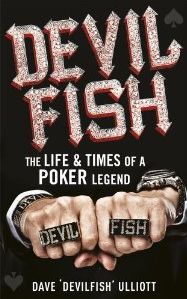Bright Lights, Late Nights and Fame at Last, Part 1
This is an excerpt from Dave ‘Devilfish’ Ulliott’s book "Devilfish – The Life & Times of a Poker Legend". The second excerpt is already available. This week we have a competition where you can win one of 3 copies of the book. Enter the competition in this thread on the forum.
Buy Devilfish – The Life & Times of a Poker Legend from Amazon.co.uk.
In early 1999 I got a call from a British TV producer called Rob Gardner who wanted me to play in a televised poker tournament. Poker had never been shown on TV before, but Rob’s idea was to put a camera on the players’ cards so people would know what they were holding. As invitations go, it didn’t sound too attractive. It was about on a level with having a boxing match wearing oven gloves, playing snooker with a stick of celery, or throwing darts blindfolded. In other words, a non-starter and a hiding to nothing all rolled into one. Why would a poker player want to show his cards?
But then Rob explained what the programme was going to be like and how the cameras were going to be used. I thought about it, and told them to count me in. The thought of being on TV was quite a thrill and I’d always been a bit of a show-off. I was now the top player in Britain in tournament wins – nine firsts, seven seconds, three thirds, and five fourths – and after my showings in Las Vegas, I was the only English guy with a gold WSOP bracelet. Apparently, Rob Gardner was a bit of a fan of mine. The show was going to be called Late Night Poker.
It wasn’t all good news, though – they were filming it in Wales. I turned up looking like the nuts, of course, in a black suit, orange shades, WSOP bracelet, gold and diamond ‘DEVIL’ ‘FISH’ rings. The line-up was really strong: Liam Flood, Dave Colclough, Joe Beevers, Surinder Sunar, Ram Vaswani, Malcolm Harwood, Barny and Ross Boatman, Dave Welch, Peter Evans, Ali Sarkeshik and Charalambos Xanthos. Every heavyweight poker player from the European scene. I knew most of them either from tournaments, casinos, cash games or illegal poker dens.
We’d be playing No Limit Texas Hold’em, which made sense for TV because it was an action game that encouraged betting, bluffing, bad beats and all-ins – it was a drawing game and it was simple to understand. Lots of times in Hold’em, the money’s all in, the cards are on their backs, and it’s in the lap of the gods who wins. People like to see all the chips get shoved in the middle and a big showdown.
There were a total of forty players who would play five eight-player heats, and the winner and runner-up of each heat would go through to a ten-player final table. The prize money for first was £40,000 – which was nothing compared to what I’d been winning in cash games and in Las Vegas but it was a pretty good prize for the first ever TV tournament. The winner also got a free buy-in to the World Series in Vegas, which was worth another $10,000.
Jesse May and Nic Szeremeta were the commentators, though Jesse was also playing in one of the heats under the name Mickey Dane, so how that was gonna work, I didn’t know. Maybe he’d commentate on his own play and predict what he was going to do.
Also playing was Sir Clive Sinclair, who’d invented the first small calculators and made some of the first home computers. He looked like a scientist, with his little grey beard and glasses, but I didn’t know him from a hole in the ground. I’d never played against a ‘Sir’ before – I’d played against 24-carat cunts, 100 per cent fuckers and total dyed-in-the-wool bastards, but never against a Sir. It caused a bit of a stir when I called him ‘son’.
It was Joe Beevers who told me all about this Clive bloke. And here was a strange thing – Joe said that when he was a kid, his dad (who was a gambler) had taught him all about probabilities and percentages in betting, and to teach him he’d used something called a ZX computer. And this ZX computer was actually invented by Sir Clive Sinclair. So years later, Joe had now found himself playing poker with the geezer who had invented the computer he used as a kid to learn how to play poker!
The big innovation for this game was the use of cameras under the tables to see the players’ hole cards. The hole-cams. They pointed up to a piece of glass that was set into the table, and when the player laid his two hole cards face down the viewers could see what he had. It was a genius idea, really. In one fell swoop it solved the big problem of televised poker – that no one knew what the hell was going on.
He was only a young kid, Rob Gardner, in his thirties, but he had the smarts to see how it could work. Before his hole-cam technology, watching poker on TV would have just left the audience wondering what was happening. Why did he do that? Why did he fold then? Now they could see for themselves why players were betting, folding, slitting their wrists. And the commentators could explain the thinking behind every move.
This is an excerpt from Dave ‘Devilfish’ Ulliott’s book "Devilfish – The Life & Times of a Poker Legend". The second excerpt is already available. This week we have a competition where you can win one of 3 copies of the book. Enter the competition in this thread on the forum.
Buy Devilfish – The Life & Times of a Poker Legend from Amazon.co.uk.

